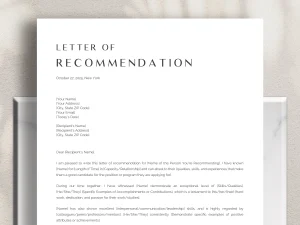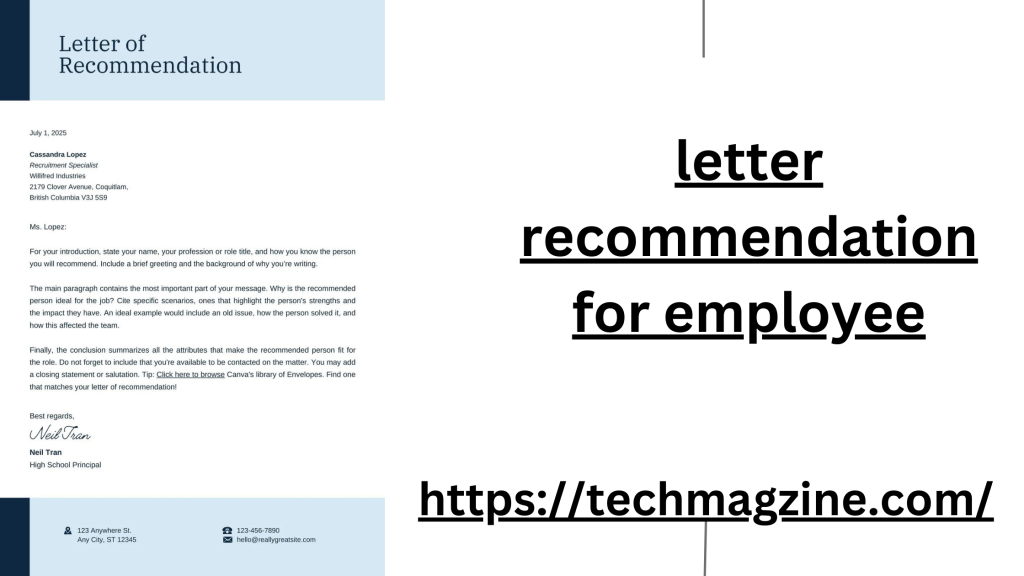A letter of recommendation for an employee is an essential document that speaks volumes about an individual’s qualifications, skills, and work ethic. Employers, colleagues, or supervisors often write these letters when an employee moves to another organization or seeks career advancement. This article delves into the purpose, structure, and best practices for crafting an effective letter of recommendation for an employee while utilizing the keyword letter recommendation for employee throughout.
Why a Letter Recommendation for Employee is Important
A well-written letter of recommendation for an employee can make a significant difference in a candidate’s career. It validates the individual’s skills and experiences from the perspective of someone who has witnessed their work. This document is often requested by prospective employers, universities, or professional organizations to assess the applicant’s credibility.
Having a strong letter of recommendation for an employee can:
- Provide evidence of the employee’s qualifications and achievements.
- Highlight their professional growth and development.
- Serve as a testament to the employee’s character and work ethic.
- Reinforce the employee’s fit for a specific role or industry.
Key Elements of a Strong Letter Recommendation for Employee
To create a persuasive and compelling letter recommendation for employee, it’s crucial to structure it thoughtfully. Below are the key elements:
1. Introduction
The introduction should clarify the writer’s relationship with the employee, their role, and how long they have known or worked with the individual. This sets the context for the rest of the letter and establishes the writer’s authority to recommend the employee.
Example: “I have had the pleasure of working closely with [Employee’s Name] for the past three years as their direct supervisor at [Company Name]. During this time, I have witnessed their exceptional skills, professionalism, and dedication to their work.”
2. Overview of Employee’s Role
The second part of the letter recommendation for employee should provide a brief overview of the employee’s role within the organization. This helps the reader understand the scope of the employee’s responsibilities and their contributions to the team.
Example: “[Employee’s Name] held the position of [Job Title] at [Company Name], where they were responsible for overseeing [specific tasks or projects]. Their role required excellent organizational and problem-solving skills, both of which they demonstrated consistently.”
3. Skills and Accomplishments
Highlighting the employee’s specific skills, strengths, and accomplishments is critical. This section should reflect the employee’s expertise in their field and how their contributions positively impacted the organization.
Example: “During their time at [Company Name], [Employee’s Name] demonstrated a keen ability to manage complex projects efficiently. They were instrumental in [mention specific projects or achievements], which resulted in [tangible outcomes such as increased revenue, improved processes, etc.]. Their attention to detail, leadership, and communication skills were invaluable to the success of the department.”
4. Work Ethic and Personal Traits
A strong letter recommendation for employee should also touch on the individual’s work ethic and personal characteristics. Attributes such as integrity, teamwork, and professionalism are essential qualities that prospective employers often look for in candidates.
Example: “[Employee’s Name] consistently displayed a high level of professionalism, a strong work ethic, and a positive attitude, even in challenging situations. They are a team player who is always willing to go the extra mile to ensure that projects are completed on time and to the highest standard.”
5. Conclusion and Endorsement
The conclusion of the letter recommendation for employee should reaffirm the writer’s recommendation and express confidence in the employee’s future success. It’s important to invite the recipient of the letter to contact the writer for any additional information or clarification.
Example: “I wholeheartedly recommend [Employee’s Name] for any position they are pursuing. Their combination of skills, work ethic, and dedication will be an asset to any organization. If you have any further questions, please feel free to contact me at [contact information].”
Best Practices for Writing a Letter Recommendation for Employee
To ensure that the letter recommendation for employee is effective, follow these best practices:
1. Be Honest and Specific
The most credible letters are those that are honest and specific. Avoid exaggerating the employee’s qualifications, but do focus on their unique strengths and accomplishments. A genuine endorsement carries more weight than vague, overly flattering statements.
2. Tailor the Letter to the Employee’s New Role
If possible, tailor the letter recommendation for employee to the position they are applying for. Highlight the skills and experiences that align with the new job, and explain how the employee’s background makes them a perfect fit for the role.
3. Keep it Professional
Maintain a professional tone throughout the letter. Although the letter is meant to be supportive, it should still reflect professionalism and focus on the employee’s work-related skills and qualities.
4. Proofread and Edit
Before sending the letter recommendation for employee, make sure it is free of spelling and grammatical errors. A polished letter reflects well on both the writer and the employee, showing attention to detail and professionalism.
When to Decline Writing a Letter Recommendation for Employee
While it may feel uncomfortable, there are instances where you should decline writing a letter recommendation for employee. For example, if you cannot speak highly of the employee’s work or if you did not work with them long enough to provide a meaningful endorsement, it’s better to decline than to provide a weak or neutral letter.
A polite way to decline is by stating: “Thank you for considering me to write a letter of recommendation. However, I feel that I may not be the best person to provide the detailed insight necessary for your recommendation.”
Example of a Letter Recommendation for Employee
To provide a clear idea of how to craft an effective letter recommendation for employee, here is a sample:

Conclusion
Writing a letter recommendation for employee is an opportunity to support a valued team member in their career advancement. By focusing on their specific skills, accomplishments, and personal traits, you can create a compelling letter that boosts their chances of success. Remember to be honest, professional, and detailed in your endorsement to ensure that the letter reflects well on both you and the employee.
